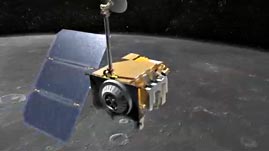Teachers' Domain - Digital Media for the Classroom and Professional Development
User: Preview

Source: NASA
Learn how surface features on the Moon indicate it is geologically active in this interactive activity adapted from NASA. In 2010, the Lunar Reconnaissance Orbiter captured images of geological features, called lobate scarps, which form when two surfaces at a thrust fault are pushed together; these features indicate that the Moon is shrinking. In 2012, new observations showed surface features, called graben, which form where the crust has pulled apart; these features are evidence that the Moon is also expanding in some places. These discoveries suggest that the Moon is still geologically active and challenge ideas about how the Moon formed and evolved.
There have been many proposed ideas for the origin of Earth's moon, but the most widely accepted model of formation is the giant impact hypothesis. According to this hypothesis, about 4.5 billion years ago, the Moon formed as a result of a giant impact between the young Earth and a large object (the impactor) about the size of Mars. The collision destroyed the impactor and ejected debris (both from Earth and the other object) into orbit around Earth. Over time, the orbiting material coalesced to form the Moon. This impact scenario would have released large amounts of energy so that the outer layer of Earth melted to form a magma ocean and the young Moon was molten.
Although humans have visited the Moon, much of what we know about it is based on data collected from ground-based telescopes and unmanned spacecraft. Scientists can apply knowledge from Earth's surface features and geologic processes to interpret observations of other solar system objects. Lunar surface features seen on images can provide information about its evolution.
Lobate scarps are cliff-like landforms that indicate global compression. A lobate scarp forms when two surfaces along a thrust fault are pushed together. They are common features on terrestrial planets, such as Mercury. When Mercury was young, it was much hotter (probably entirely molten); as it cooled, the planet contracted and shrunk. Because the crust is solid, the surface was forced to buckle in places to accommodate the shrinking surface area. In 2010, images from NASA's Lunar Reconnaissance Orbiter, showed lobate scarps on the Moon's surface, indicating that the Moon is also shrinking. Based on the condition of the lobate scarps—the features were crisp, had little deterioration, and cut across small craters—they were determined to be relatively young. Because there is no atmosphere on the Moon, the lunar surface does not change from processes such as erosion from wind or rain; however, small features do not usually last long because of the regular bombardment from meteorites.
In 2012, the discovery of graben—narrow trenches between parallel faults that indicate expansion—on the Moon's surface seemed to contradict the earlier finding that the Moon was shrinking. Graben form where the crust is stretched apart, which causes it to break and form a valley. The observed graben were not yet marred by impact craters, suggesting recent geologic activity within about 50 million years. The combination of surface features suggest that the Moon is not contracting strongly enough to suppress the formation of graben and that perhaps only the exterior of the early Moon was molten (rather than the entire Moon). If the Moon was completely molten during an early stage of formation, it should be contracting more strongly.
There has been significant evidence to support the giant impact hypothesis but there are many questions yet to be answered. Scientific hypotheses evolve over time as new evidence is discovered. New findings offer insights into the Moon's formation and evolution and researchers continue to look for clues to its history.
Here are suggested ways to engage students with this interactive and with activities related to this topic.
 Loading Standards
Loading Standards